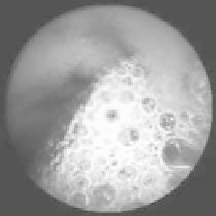Biomedical Engineering Reference
In-Depth Information
(a)
(b)
(c)
Figure 20.
Another segmentation of bubbles using confidence rate spaces: (a) original
image; (b) confidence rate of an adaboost classifier trainedwith a bubblemodel; (c) resulting
segmentation. See attached CD for color version.
by decoupling the convergence from the regularity. This decoupling has several
advantages over existing geodesic formulations. On one hand, the numeric scheme
is more efficient since it admits arbitrary large time increments, except for the
last regularizing steps. On the other hand, we built a robust vector field ensuring
convergence but, at the same time, snake stabilization. Convergence is achieved by
defining separately a dynamic attractive term and an image feature-based repulsive
one. We also introduce likelihood maps to decouple as well as to define the STOP
term of the external potential vector field. By using likelihood maps as an external
force, the particular version of
STOP and GO
presented in here is suited to feature
space-based image segmentation (texture, motion, color schemes).
We have also introduced three different alternate spaces that can be used in
conjunction with our formulation: the filter space maps, the likelihood maps,
and the classification confidence rate map. We have applied these techniques in
two different image modalities — intravascular ultrasound images and intestinal
images — with great success.
8.
ACKNOWLEDGMENTS
This work was partly supported by GivenImaging, Israel.
9.
REFERENCES
1. Kass M, Witkin A, Terzopoulos D. 1988. Snakes: active contour models.
Int J Comput Vision
1
:321-331.
2. Caselles V, Catte F, Coll T, Dibos F. 1993. A geometric model for actives contours.
Num Math
66
:1-31.
3. Cohen LD. On active contour models and ballons.
Comput Vision Graphics Image Process:
Image Understand
53(2):211-218, 1991.



